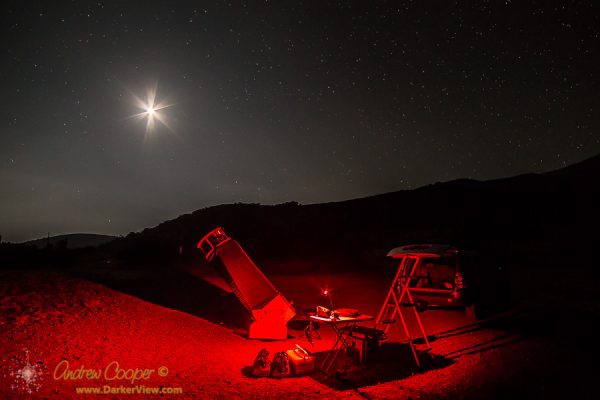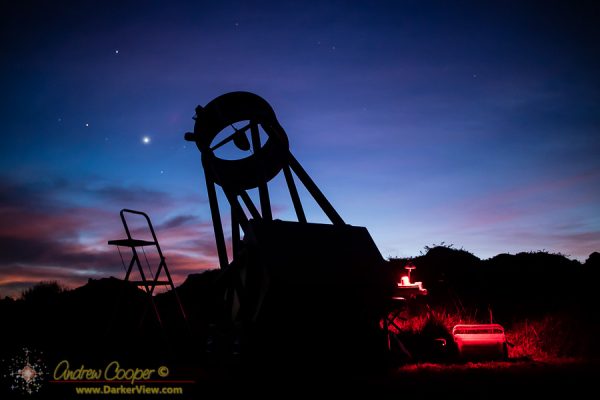
Tag: observing
Waiting for Moonset
Obsession in the Twilight
Observing at Kaʻohe
A dark night under the stars! It has been too long… Why not?
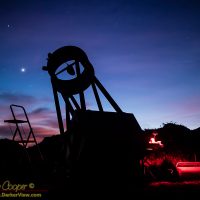
After all the work restoring the 20″ Obsession it was time to get it out under the stars for a decent observing run. During the many hours of work I had looked forward to simply using this telescope for a bit. While it would eventually be stored at the observatory and used for outreach, it seemed a shame not to spend a night or two under the stars with this instrument. Not like I need a 20″ telescope, my 18″ is just fine, but I loaded it up just the same, leaving Deep Violet in the garage.
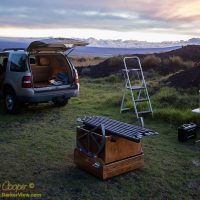
My favorite close by site is KaʻOhe, taking only a twenty minute drive from home to reach. At 5,700 feet on the side of Mauna Kea nearby home does not mean second rate. I really like this spot, the view is spectacular with the coastline below and the Mauna Loa and Hualālai volcanoes dominating the horizon. The entire southern horizon is unobstructed, allowing observations of southern objects right down to the horizon.
Better yet, recent rains meant green grass and a spot near the road maintenance gravel pile was hard packed rock, no dust! The area had even been mown recently! I sometimes have a few uncharitable words to describe DLNR, but not this evening.
A Solo Messier Marathon
Yeah, I did another Messier marathon, You know, that crazy exercise where you attempt to find all 110 Messier objects in a single night. A bit crazy, but also rather addicting. I am a somewhat of a purist, I use no computerized telescope, just a chart, a Telrad, and my knowledge of the night sky. This makes a Messier marathon a real challenge.
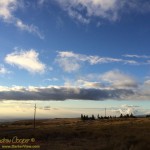
Even if the clouds spoiled the event there was not much to risk. May as well pack up and drive to the site, as the organizer I pretty much had to be there in case any of the others responded to my invitation. This outing would not take much preparation, a cooler packed with munchies and drinks to get me through the night and one of my smaller telescopes. There is not much question as to which telescope I will use… Primero, my 6″ RFT and the veteran of many Messier marathons. it is this instrument with which I achieved my one perfect 110 score at the All Arizona Messier Marathon many years ago.
Mauna Kea Messier Marathon March 12
We are good to go! I have the DLNR permit for using the site. We will hold the Mauna Kea Messier Marathon 2016 on the evening of March 12 at the Ka’ohe observing site.

Astronomical twilight ends: 19:44 HST
Astronomical twilight begins: 05:19 HST
Sunrise: 06:32 HST
Please arrive before sunset so as not to annoy other observers with lights and dust, allowing a few extra minutes to find the setup site. This will provide plenty of time to set up gear and have a picnic dinner. I hope to be at the site around 5:30pm. I will sign the group in at the check-in station with the permit number, you need not sign in.
For those who wish to marathon I will have a checklist available for the effort. There are a lot of MM checklists, the one I provide is optimized for our 20N latitude which changes the priority of the evening and morning objects. If you do not want to participate, just come to observe.
If you are participating in the MM I would also suggest a low-power, wide field instrument. Smaller telescopes are actually better at this pursuit than larger. For MM I leave the 18″ at home and bring a 6″ telescope. Any finding aids are acceptable, including GOTO. If you are a purist like me? I will use nothing but a chart and a Telrad to locate the objects.
The site is to be found along the old Saddle Road just above the Kilohana hunter check in station. There is a line of pine trees a couple hundred yards above the gate, I plan to set up on the makai side of the trees where you will find a large flat area and a big pile of gravel stockpiled. A precise location and Google map for the Ka’ohe site can be found here.
A reminder that the DLNR permit has a few restrictions, nothing we would not do anyway… No open flame, no hunting, and please keep the area clean.
Now all we need is clear weather for a successful Marathon!
Kaʻohe Observing Site
Looking for a site that is a bit closer to home than driving all the way to the Mauna Kea VIS? Maybe not quite as high up the mountain, not as cold or windy? There is not a lot to choose from on Mauna Kea, much of the land is controlled access, either DLNR or private ranch land. Locked gates are the standard solution around the island.
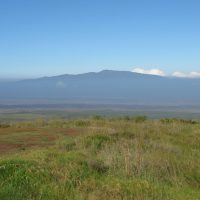
There is a gate that is generally not locked. The hunter check-in station at Kilohana that provides access to the Kaʻohe game Management Area. Starting at 5,700 feet from the Old Saddle Road the R-1 road climbs the mountain from here.
The actual spot I use is a staging area used by DLNR crews, hunters and the ATV riders who normally frequent the area. From the neat lines of pine trees it looks like the site was once a homestead or ranch house of some sort built high on the side of the mountain. It is about 1/4mile above Old Saddle Road and the Kilohana hunter check in station and directly adjacent to the R-1 road.
As usual you need to obey DLNR rules for access to the site. The R-1 road is designated a public access trail under the Nā Ala Hele trail system, so a permit should not be required. You must not be “camping”, this is defined by the DLNR as being in possession of “camping paraphenalia”, like sleeping bags, tent, etc., during the hours of darkness.
There is a sign in and out form at the hunter check-in station. The DLNR states that 4WD is required to use the R-1 road, but in reality the old homestead could be reached by any vehicle, the first part of this road is quite nice, basic gravel, the rough stuff is far higher up the mountain.
The site has many advantages. It is just far enough off the Old Saddle Road as to avoid vehicle headlights. Not that there is much traffic on the old road, the new road has accommodated most of the across island traffic and it is miles below the site.
One of the best features of the site is shelter from the strong trade winds that sweep across the island. The trades are generally from the northeast, while the site is on the southwest flank, sheltered in the lee of a 14,000ft mountain. I have seen days when the trades were howling in Waimea and Waikoloa, while it was dead calm at Kaʻohe.
You can get some fog and dew here in the evening. At 5,800 feet elevation you are just at the top of the inversion cloud level, sometimes just below. When it is clear it is glorious here, but you can get evening fog until the cooling night allows the sea breeze to wane and the cloud level to subside. You can always pass the site up and head on to the VIS if the cloud tops are higher.

As with any site on the slopes of Mauna Kea, air currents around the mountain can cause some seeing issues. The site should be less susceptible to cold down slope flows than the VIS area as it sits upon a ridge line, not a depression.
The game management area can occasionally be closed to access by the DLNR for one reason or another. You can check the DLNR website or the Nā Ala Hele trail system webpage. Closures should also be marked at the hunter check-in station.
The site is most easily reached from the new Saddle Road (Daniel K. Inouye Highway) in the valley below. Turning up the old road near milepost 42 and driving one mile up to Kilohana. If you see the girl scout camp you missed the turn by a bit.
I have used the site many times, and have also observed from the nearby Kilohana Girl Scout Camp, and been very pleased with the observing. I suspect I will use the site again in the near future.
Directions from Waimea
- Drive south on the Mamalahoa Highway towards Kona
- 6.2 miles from the Lindsey road light you will reach the old Saddle Road intersection, turn left uphill
- Proceed 10.2 miles to the Kaʻohe GMA entrance with a sign and yellow gate, the signs also say Kilohana Hunter Check-In Station
- Proceed 0.2 miles on the dirt road to the site, the site is on the left in front of the pine trees
Directions from Kona
- Drive 24 miles north from Kona on the Mamalahoa Highway (upper road)
- Turn right on Saddle Road (Daniel K. Inouye Hwy.)
- Proceed 9.6 miles on Saddle to the Old Saddle intersection
- Turn left onto the Old Saddle Road
- Proceed 1.1 miles to the Kaʻohe GMA entrance with a sign and yellow gate, the signs also say Kilohana Hunter Check-In Station
Proceed 0.2 miles on the dirt road to the site, the site is on the left in front of the pine trees
Directions from Hilo
- Drive across island on Saddle Road (Daniel K. Inouye Hwy.) to near milepost 42
- Turn left up the old Saddle Road
- Proceed 1.1 miles to the Kaʻohe GMA entrance with a sign and yellow gate, the signs also say Kilohana Hunter Check-In Station
- Proceed 0.2 miles on the dirt road to the site, the site is on the left in front of the pine trees
Observing from Kaʻohe
A beautiful night on the side of Mauna Kea!

I needed some altitude! But I did not want to go to the VIS, it was cold and windy up there. A compromise was decided upon, if the clouds proved low enough I would go to the Ka’ohe site on the old Saddle Road. Only 5’800 feet elevation is a compromise between getting above the clouds, it is usually just high enough, and staying warm. On the west face of the mountain the winds are usually mild. This is only the second time I have used the site. Not that the site is new, I had noted this place as a possible observing site many years ago, it is only recently I have begun using it.
I have also been working on the ‘scope a bit. Now over a decade old the 11″ NexStar is in need of some TLC. A replaced GPS battery, a new power connector in the base, a little lube in the slip rings, a repaired solder connection also in the slip rings, etc., etc. She is working pretty well now, the GOTO system hitting target after target with precision. Thus I was looking to use the 11″ instead of the 18″, though this limited my magnitude a bit. I set up my observing lists for a maximum magnitude of 13.
What to observe? Just query my observing list generator for a list of whatever I have not observed in the area. I usually work in 30° x 2 hour section of the sky. This evening would see me south of Orion in Lepus, Eridanus, and Columba. What I did not expect is that everything I had not observed down there was a small, dim 12-13 magnitude galaxy! Everything!
NGC1993 Small, very faint, round 1′ in diameter, stellar core
NGC2089 Small, faint, round 1′ in diameter, stellar core
So it went, galaxy after galaxy, the variation was usually some version of faint… “Faint”, “Very faint”, “Quite faint”, to the limit of my vision “Averted vision required with the 28cm”. A bright star or another galaxy in the same field was exciting!
Normally when working a region of the sky I find quite a few plain objects, the usual slew of dim galaxies when off the galactic plane, open clusters in the plane. Usually there is the occasional gem sprinkled in to liven the observing session. Not tonight!
Still, it was very nice to be out under the stars. It was a completely dark night, the sky brilliant with Orion and Canis Major high overhead. I was sitting just at the top of the cloud deck, the cars far below me on Saddle Road creating a dim glow in the clouds. Across the top of the clouds I could see Mauna Loa and Hualalai lit by starlight and skyglow.
A solid three hours at the eyepiece, three pages of notes, and I was out of hot tea. I put down the unending list of dim galaxies and just spent a bit looking up some old favorites. The Orion nebula was stunning in the eyepeice, R Lep is still very, very red. Finally breaking down and heading home, I was in bed about midnight.
Sentinel
BLNR Approves Access Restrictions on Mauna Kea
Friday night the Board of Land and Natural Resources approved rules restricting access to Mauna Kea.
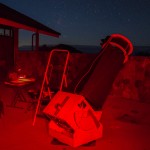
I have yet to locate a copy of the final approved rules, it is only a few minutes ago that the decision was approved. I expect they will appear on the DLNR website eventually (Tonight? Monday?). They are effective immediately, I would expect there to be a legal requirement to post them.
It is safe to say that there will be no overnight observing at or near the Mauna Kea VIS. You will need to find a site elsewhere or at least one mile from the access road.
These rules are effective for 120 days, after which we will see what happens. In that time they may be allowed to lapse. It also allows the DLNR time to approve similar, permanent rules through the regular process in place of these emergency rules.
120 days and counting… I make that November 8th, 2015.
Update: Found them!
(a) The area referred to in this rule as the “restricted area” is defined as any lands in the public hunting area that includes the Mauna Kea Observatory Access Road and one mile on either side of the Mauna Kea Observatory Access road.
(b) As used in this rule, the term “transiting” means operating, or being a passenger in, a motor vehicle traveling at a reasonable and prudent speed and having regard to the actual and potential hazards and conditions then existing.
(c) No person shall at any time possess or control in the restricted area any of the following items: sleeping bag, tent, camping stove, or propane burner.
(d) No person shall enter or remain in the restricted area during the hours of 10:00 p.m. to 4:00 a.m., unless the person is transiting through the restricted area on the Mauna Kea Observatory Access Road or is lawfully within or entering or exiting an existing observatory or a facility operated by the University of Hawaii.

